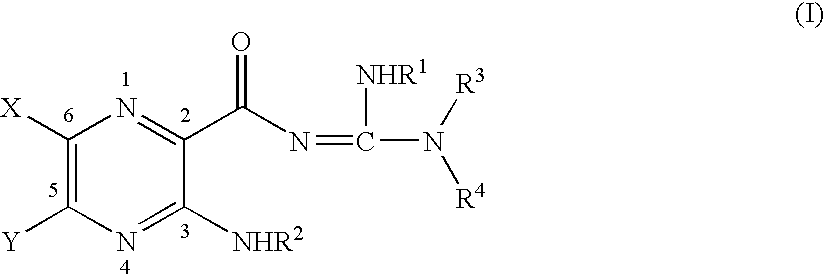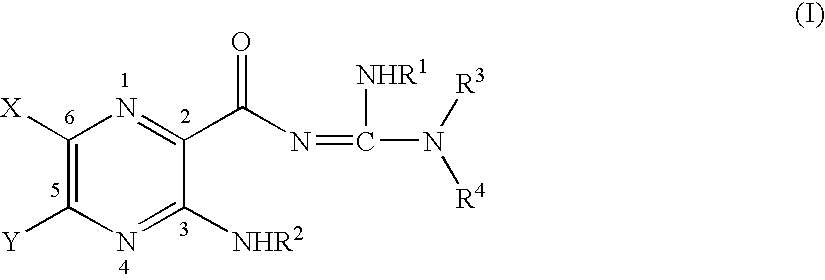Aliphatic amide and ester pyrazinoylguanidine sodium channel blockers
a technology of aliphatic amide and ester pyrazinoylguanidine, which is applied in the direction of drug compositions, extracellular fluid disorders, metabolic disorders, etc., can solve the imbalance between the amount of liquid and the amount of liquid, and the inability to clear mucus from the airway surface, etc., to achieve less reversible, less reversible, and more potent
- Summary
- Abstract
- Description
- Claims
- Application Information
AI Technical Summary
Benefits of technology
Problems solved by technology
Method used
Image
Examples
example 1
Synthesis of 11-[N-(3,5-diamino-6-chloropyrazine-2-carbonyl)guanidino]undecanoic acid (ALB 26795)
[0388]
11-[N-(3,5-Diamino-6-chloropyrazine-2-carbonyl)guanidino]undecanoic acid (2, ALB 26795)
[0389]Diisopropylethylamine (1.05 mL, 6.01 mmol) and 1-(3,5-diamino-6-chloropyrazine-2-carbonyl)-2-methylisothiourea hydriodide (600 mg, 1.54 mmol) were added sequentially to a suspension of amino acid 1 (300 mg, 1.49 mmol) in ethanol (10 mL). The reaction was heated to 75° C. for 6 hours after which time the reaction was cooled and the solvent removed under vacuum. Purification of the residue by column chromatography (silica gel, gradient of 100:0:0 to 89:10:1 dichloromethane / methanol / ammonium hydroxide, v / v) and subsequent precipitation from ethanol gave a yellow solid (527 mg). A 100 mg aliquot of this material was dried in a vacuum oven at 60° C. for 48 hours to provide compound 2 (96 mg, 80%) as a yellow solid: 1H NMR (500 MHz, DMSO-d6) δ 1.24-1.34 (m, 12H), 1.46-1.51 (m, 4H), 1.73-1.79 (m, ...
example 2
Synthesis of 11-[N-(3,5-diamino-6-chloropyrazine-2-carbonyl)guanidino]undecanoic acid (3-dimethylaminopropyl)amide (ALB 27160)
[0390]
11-tert-Butoxycarbonylaminoundecanoic acid (3)
[0391]Sodium hydroxide (2.18 g, 54.5 mmol) was added to a suspension of 11-aminoundecanoic acid (1) (5.00 g, 24.8 mmol) in a mixture of tetrahydrofuran and water (260 mL, 1:1). The resulting solution was stirred for 10 minutes, then di-tert-butyl dicarbonate (6.50 g, 29.8 mmol) added and the reaction stirred at ambient temperature for 14 hours. The solvent was then removed under vacuum. The resulting white solid was dissolved in chloroform, and the solution washed with a 1 N HCl (3×100 mL), dried over anhydrous magnesium sulfate and concentrated to give 3 (6.99 g, 93%) as a white solid: 1H NMR (500 MHz, CDCl3) δ 1.28 (s, 12H), 1.44 (br, 11H), 1.56-1.66 (m, 2H), 2.34 (t, 2H, 3=7.4 Hz), 3.08-3.11 (m, 2H).
[10-(3-Dimethylaminopropylcarbamoyl)decyl]carbamic acid tert-butyl ester (4)
[0392]1,1′-Carbonyldiimidazole ...
example 3
Synthesis of N-(3,5-diamino-6-chloropyrazine-2-carbonyl)-N-(11-oxo-11-piperazin-yl-undecyl)guanidine (ALB 27161)
[0395]
4-(11-tert-Butoxycarbonylaminoundecanoyl)piperazine-1-carboxylic acid tert-butyl ester (7)
[0396]1,1′-Carbonyldiimidazole (118 mg, 0.73 mmol) was added to a solution of acid 3 (200 mg, 0.66 mmol) in tetrahydrofuran (5 mL) and the mixture stirred for 4 hours. A solution of N-tert-butoxycarbonylpiperazine (148 mg, 0.79 mmol) in tetrahydrofuran (2 mL) was added and the reaction stirred for an additional 14 hours at room temperature. The solvent was then removed under vacuum and the residual oil purified by column chromatography (silica gel, gradient 99:1 to 95:5 dichloromethane / methanol, v / v) to afford 7 (204 mg, 66%) as a white solid: 1H NMR (500 MHz, CDCl3) δ 1.27 (m, 12H), 1.41-1.51 (m, 21H), 1.56-1.66 (m, 5H), 2.32 (t, 2H, J=7.5 Hz), 3.08-3.11 (m, 2H), 3.38-3.41 (m, 2H), 3.56-3.59 (m, 2H), 4.51 (br, 1H); m / z (ESI) 470 [C25H47N3O5+H]+.
11-Amino-1-piperzin-1-yl-undecane...
PUM
| Property | Measurement | Unit |
|---|---|---|
| size | aaaaa | aaaaa |
| size | aaaaa | aaaaa |
| size | aaaaa | aaaaa |
Abstract
Description
Claims
Application Information
 Login to View More
Login to View More - R&D
- Intellectual Property
- Life Sciences
- Materials
- Tech Scout
- Unparalleled Data Quality
- Higher Quality Content
- 60% Fewer Hallucinations
Browse by: Latest US Patents, China's latest patents, Technical Efficacy Thesaurus, Application Domain, Technology Topic, Popular Technical Reports.
© 2025 PatSnap. All rights reserved.Legal|Privacy policy|Modern Slavery Act Transparency Statement|Sitemap|About US| Contact US: help@patsnap.com



